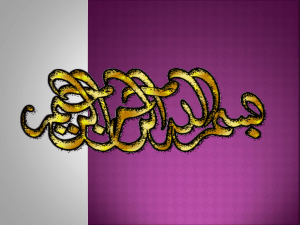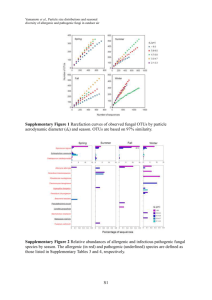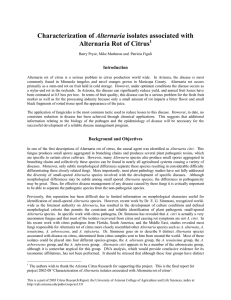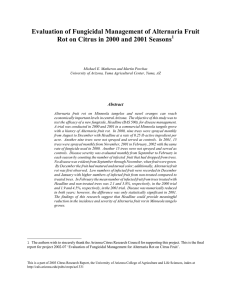Development of selective media for the isolation Alternaria and plant debris
advertisement
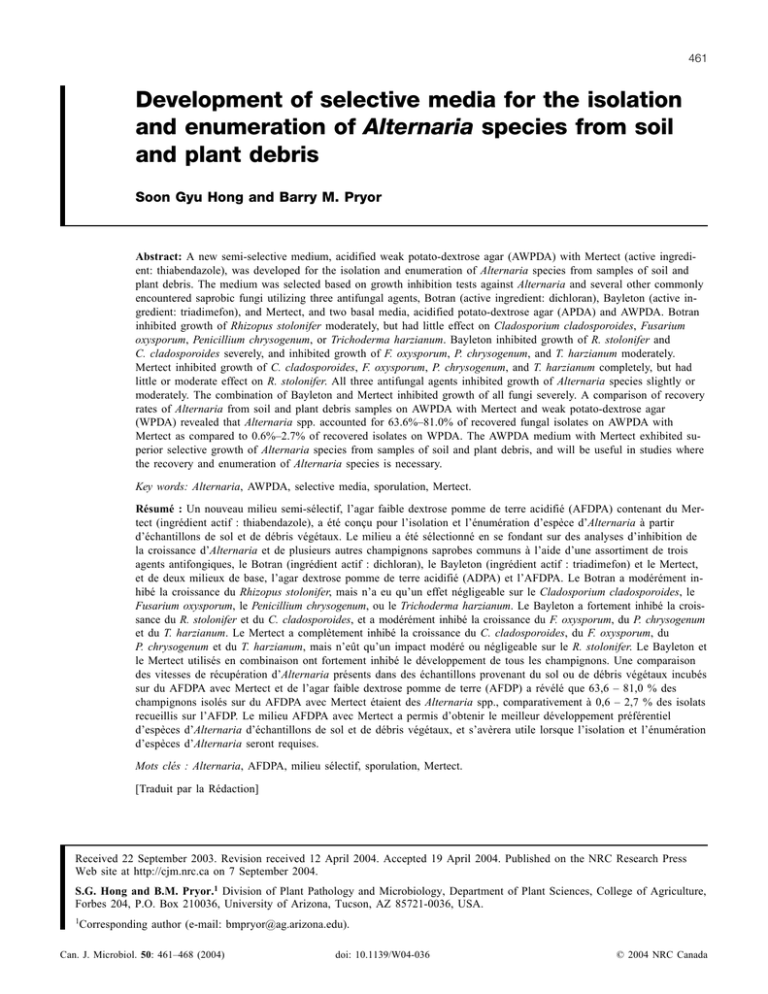
461 Development of selective media for the isolation and enumeration of Alternaria species from soil and plant debris Soon Gyu Hong and Barry M. Pryor Abstract: A new semi-selective medium, acidified weak potato-dextrose agar (AWPDA) with Mertect (active ingredient: thiabendazole), was developed for the isolation and enumeration of Alternaria species from samples of soil and plant debris. The medium was selected based on growth inhibition tests against Alternaria and several other commonly encountered saprobic fungi utilizing three antifungal agents, Botran (active ingredient: dichloran), Bayleton (active ingredient: triadimefon), and Mertect, and two basal media, acidified potato-dextrose agar (APDA) and AWPDA. Botran inhibited growth of Rhizopus stolonifer moderately, but had little effect on Cladosporium cladosporoides, Fusarium oxysporum, Penicillium chrysogenum, or Trichoderma harzianum. Bayleton inhibited growth of R. stolonifer and C. cladosporoides severely, and inhibited growth of F. oxysporum, P. chrysogenum, and T. harzianum moderately. Mertect inhibited growth of C. cladosporoides, F. oxysporum, P. chrysogenum, and T. harzianum completely, but had little or moderate effect on R. stolonifer. All three antifungal agents inhibited growth of Alternaria species slightly or moderately. The combination of Bayleton and Mertect inhibited growth of all fungi severely. A comparison of recovery rates of Alternaria from soil and plant debris samples on AWPDA with Mertect and weak potato-dextrose agar (WPDA) revealed that Alternaria spp. accounted for 63.6%–81.0% of recovered fungal isolates on AWPDA with Mertect as compared to 0.6%–2.7% of recovered isolates on WPDA. The AWPDA medium with Mertect exhibited superior selective growth of Alternaria species from samples of soil and plant debris, and will be useful in studies where the recovery and enumeration of Alternaria species is necessary. Key words: Alternaria, AWPDA, selective media, sporulation, Mertect. Résumé : Un nouveau milieu semi-sélectif, l’agar faible dextrose pomme de terre acidifié (AFDPA) contenant du Mertect (ingrédient actif : thiabendazole), a été conçu pour l’isolation et l’énumération d’espèce d’Alternaria à partir d’échantillons de sol et de débris végétaux. Le milieu a été sélectionné en se fondant sur des analyses d’inhibition de la croissance d’Alternaria et de plusieurs autres champignons saprobes communs à l’aide d’une assortiment de trois agents antifongiques, le Botran (ingrédient actif : dichloran), le Bayleton (ingrédient actif : triadimefon) et le Mertect, et de deux milieux de base, l’agar dextrose pomme de terre acidifié (ADPA) et l’AFDPA. Le Botran a modérément inhibé la croissance du Rhizopus stolonifer, mais n’a eu qu’un effet négligeable sur le Cladosporium cladosporoides, le Fusarium oxysporum, le Penicillium chrysogenum, ou le Trichoderma harzianum. Le Bayleton a fortement inhibé la croissance du R. stolonifer et du C. cladosporoides, et a modérément inhibé la croissance du F. oxysporum, du P. chrysogenum et du T. harzianum. Le Mertect a complètement inhibé la croissance du C. cladosporoides, du F. oxysporum, du P. chrysogenum et du T. harzianum, mais n’eût qu’un impact modéré ou négligeable sur le R. stolonifer. Le Bayleton et le Mertect utilisés en combinaison ont fortement inhibé le développement de tous les champignons. Une comparaison des vitesses de récupération d’Alternaria présents dans des échantillons provenant du sol ou de débris végétaux incubés sur du AFDPA avec Mertect et de l’agar faible dextrose pomme de terre (AFDP) a révélé que 63,6 – 81,0 % des champignons isolés sur du AFDPA avec Mertect étaient des Alternaria spp., comparativement à 0,6 – 2,7 % des isolats recueillis sur l’AFDP. Le milieu AFDPA avec Mertect a permis d’obtenir le meilleur développement préférentiel d’espèces d’Alternaria d’échantillons de sol et de débris végétaux, et s’avèrera utile lorsque l’isolation et l’énumération d’espèces d’Alternaria seront requises. Mots clés : Alternaria, AFDPA, milieu sélectif, sporulation, Mertect. [Traduit par la Rédaction] Hong and Pryor 468 Received 22 September 2003. Revision received 12 April 2004. Accepted 19 April 2004. Published on the NRC Research Press Web site at http://cjm.nrc.ca on 7 September 2004. S.G. Hong and B.M. Pryor.1 Division of Plant Pathology and Microbiology, Department of Plant Sciences, College of Agriculture, Forbes 204, P.O. Box 210036, University of Arizona, Tucson, AZ 85721-0036, USA. 1 Corresponding author (e-mail: bmpryor@ag.arizona.edu). Can. J. Microbiol. 50: 461–468 (2004) doi: 10.1139/W04-036 © 2004 NRC Canada 462 Introduction The genus Alternaria Nees includes a diverse assemblage of species that occur worldwide in a variety of habitats (Joly 1964; Ellis 1971, 1976; Simmons 1992). Many species are common saprobes and are ubiquitous agents of decay (Rotem 1994). Numerous records report the recovery of species from such diverse substrates as sewage, leather, wood, paper products, textiles, building supplies, stone monuments, optical instruments, cosmetics, computer disks, and jet fuel (McGinnis et al. 1975; Rebrikova and Sizova 1975; AbdelHafez and el-Sharouny 1990; Inoue and Koyano 1991; McCain and Mirocha 1994; Hirsch et al. 1995; Das et al. 1997; Yang and Rossignol 1999; Darby et al. 2001), and their role in the degradation of manufactured products causes untold commercial losses worldwide. As plant pathogens, more than 4000 Alternaria–host associations are recorded in the USDA Fungal Host Index, and the genus ranks 10th among nearly 2000 fungal genera listed, based on the total number of host records (Farr et al. 1989). As decomposers of foodstuffs, Alternaria spp. are ubiquitous postharvest pathogens that contribute to the spoilage of 25%–50% of agricultural output (Rotem 1994; Wilson and Wisniewski 1994). Alternaria species are some of the most prodigious producers of toxic secondary metabolites, and more than 70 compounds of varying toxicity have been reported to date (Montemurro and Visconti 1992). Relationships between Alternaria toxins and cancer development have been found in epidemiological studies and mutagenicity testing of select Alternaria metabolites (Gui-ting et al. 1992; Schrader et al. 2001). As such, the occurrence of Alternaria spp. and associated metabolites in foodstuffs, such as grains, nuts, fresh fruits, and vegetables, is becoming an increasing environmental concern (Bottalico and Logrieco 1998). In medical mycology, Alternaria species and related taxa are gaining prominence as human pathogens, particularly in immunocompromised patients (Rossmann et al. 1996; Anaissie et al. 1989). Several Alternaria species and numerous uncharacterized Alternaria taxa have been found to be associated with infections of the cornea, oral and sinus cavities, respiratory tract, skin, and nails (De Bievre 1991; Gianni et al. 1997; Ogawa et al. 1997; de Hoog et al. 2000). In a number of cases, these infections have been fatal (Neumeister et al. 1994). Perhaps more importantly, Alternaria spores are some of the most common and potent airborne allergens (Wilken-Jensen and Gravesen 1984; Karlsson-Borga et al. 1989). In the US alone, more than $3 billion are spent annually to relieve allergic rhinitis (Meltzer and Grant 1999), much of which is due to sensitization to Alternaria spores. In addition, Alternaria sensitization has been determined to be one of the most important contributing factors in the onset of childhood asthma in the southwest deserts of the US and in other arid regions (Peat et al. 1993; Halonen et al. 1997). Despite the importance of Alternaria as a plant pathogen, spoilage organism, human pathogen, and allergen, little is known about the distribution and prevalence of Alternaria spp. in natural or other environments. This lack of data is due, in part, to the lack of efficient isolation and enumeration methods in the presence of competing organisms. To de- Can. J. Microbiol. Vol. 50, 2004 tect and isolate Alternaria spp., water agar, potatosaccharose agar, carrot-leaf agar, acidified potato-dextrose agar, and potato-dextrose agar with benomyl have been used (Strandberg 1987; Bottalico and Logrieco 1992; Peever et al. 1999; Aradhya et al. 2001; Pryor and Michailides 2002). However, these media are not selective for Alternaria species, and most of these studies have involved isolating nearly pure cultures from diseased leaves. Therefore, they are not adequate to enumerate Alternaria species from samples of soil or plant debris, where a high percentage of recoverable organisms are not Alternaria spp. Pryor et al. (1992) developed A. radicina semi-selective agar (ARSA), a semi-selective medium for isolating and enumerating Alternaria radicina Meier, Drechsler & Eddy from carrot seeds and field soil in the presence of competing microflora (Pryor et al. 1994, 1998). The medium was specifically developed to detect and isolate a single Alternaria species, and is not suitable for isolating other Alternaria species, particularly small-spored catenulate species related to Alternaria alternata (Fr.) Keissler and Alternaria tenuissima (Nees & Nees : Fr.) Wiltshire, which are some of the most common fungi found in soil and plant debris. The purpose of this study was to develop a selective medium for Alternaria that would be useful for isolating and enumerating various Alternaria species, particularly small-spored catenulate species, in the presence of other saprobic fungi that are frequently found in soil and plant debris. Materials and methods Fungal strains and media In this study, six representative Alternaria isolates from five major species-groups of the genus, based on phylogenetic analysis of ITS, SSU, and gpd sequences, were used (Pryor and Bigelow 2003): A. alternata (BMP 0269); A. tenuissima (BMP 0304); A. radicina Meier, Drechsler, & Eddy (BMP 0079); Alternaria infectoria Simmons (BMP 0036); Alternaria brassicicola (Schweinitz) Wiltshire (BMP 0325); and Alternaria porri (Ellis) Cif. (BMP 0176). Also used were five mitosporic fungi that are frequently found in soil and plant debris samples: Cladosporium cladosporoides (Fresenius) de Vries (BMP 1174); Fusarium oxysporum Schlechtendahl : Fries (BMP 1169); Penicillium chrysogenum Thom (BMP 1175); Rhizopus stolonifer (Ehrenberg : Fries) Lind (BMP 1172); and Trichoderma harzianum Rifai (BMP 1170). Two basal media, amended with antifungal agents, were tested for selective growth of Alternaria species: acidified potato-dextrose agar (APDA), consisting of 39 g potatodextrose agar (Difco Laboratories, Detroit, Mich.) in 1 L deionized H2O, acidified by adding 1.25 mL of 20% lactic acid after autoclave; and acidified weak potato-dextrose agar (AWPDA), consisting of 1.2 g potato-dextrose broth (Difco Laboratories) and 16 g Bacto-agar (Difco Laboratories) in 1 L deionized H2O, acidified by adding 0.3 mL of 20% lactic acid after autoclave. Each medium was prepared, after being autoclaved and cooled down to 55 °C, by adding one or a combination of three fungicides: 5 mg of Botran (active ingredient: dichloran) (75WP, Gowan Company, Yuma, Ariz.), 200 mg of Bayleton (active ingredient: triadimefon) (50 WP, Miles, Inc., Kansas City, Mo.), or 0.25 mL of © 2004 NRC Canada Hong and Pryor Mertect 340-F (Syngenta, Basel, Switzerland) per 1 L medium. Rates for fungicides amended to the media were based on previous work in the development of the ARSA (Pryor et al. 1994). Tolerance of fungal isolates to antifungal agents in pure culture To examine the effect of each fungicide on the radial growth of fungal isolates, basal culture media and media amended with one or a combination of fungicides were inoculated with 4-mm discs taken from actively growing 3-dayold cultures of each fungal isolate, which were prepared by spreading a conidial suspension evenly over the surface of Petri dishes containing weak potato-dextrose agar (WPDA), containing 1.2 g potato-dextrose broth and 1.6% Bacto-agar and 1 L deionized H2O. Inoculated plates were incubated under fluorescent light at ambient laboratory conditions to induce sporulation of fungi, particularly Alternaria species. Colony diameter was measured after 1, 2, 3, 6, and 9 d of incubation, or until growth tips reached the margin of the media. The experiment was replicated with three plates per treatment. The mean value of the largest and smallest colony diameters was used to calculate radial growth rate per day. Radial growth was calculated by subtracting the inoculated agar block diameter (0.4 cm) from the colony diameter, and dividing it by 2. Radial growth rates from three replications were averaged to obtain a mean radial growth rate for each isolate on each medium. The growth of each fungal isolate on each fungicide-amended medium was expressed as the proportion of the growth on nonamended basal media (growth ratio). The relative sporulation level of each isolate on each medium was scored using a rating system, where 1 = no conidia, 2 = less than 20% of control (sporulation on WPDA), 3 = between 20 and 80% of control, and 4 = over 80% of control. This experiment was repeated twice. Recovery and enumeration of Alternaria from inoculated and native soil and plant debris samples Based upon results of the fungicide tolerance trials, the recovery and enumeration of Alternaria was evaluated on inoculated and native soil and plant debris samples. An isolate of A. alternata was grown on WPDA for 7 d at ambient laboratory temperature under fluorescent lights to induce sporulation. After incubation, a spore suspension was prepared by flooding plates with 5 mL of sterile resuspension solution (0.1% Tween 20 and 20% glycerol in deionized H2O). The spore suspension (1 mL) was added to 40 mL of 0.1% agar solution (1/40 dilution v/v) and mixed on the shaker for 1 h at 180 r/m. This solution was further diluted (1/10 and 1/100). To determine the population of viable fungal spores and to determine the effect of Mertect on spore germination, 200 µL of each dilution were plated on three plates each of WPDA and AWPDA with Mertect, using a bent glass rod and a plate turntable, and incubated for 7 d at ambient laboratory temperature under fluorescent lights. Colony counts of the three replicate plates were averaged to obtain a mean colony-forming units (CFU) and standard error for each medium. This experiment was repeated twice. One soil and one plant debris sample, each an independent composite of 10 subsamples collected from 10 sites on the University of Arizona campus, were used to test recov- 463 ery of Alternaria. To determine the effects of the physical presence of soil particles or plant debris on Alternaria recovery, 1 mL of spore suspension was added to 4 g each of autoclaved soil and autoclaved plant debris, mixed well, and left to dry for 1 h in a laminar flow hood. Each sample was suspended in 40 mL of 0.1% agar solution and treated with the same mixing, dilution, and plating procedure as previously described. Plates were incubated for 7 d under fluorescent lights at ambient laboratory conditions, and Alternaria CFU were enumerated on the basis of the characteristic conidiation pattern and conidia morphology of Alternaria species, using a dissecting microscope (90×). Colony counts of the three replicate plates were averaged to obtain a mean CFU and standard error for each sample on each medium. Noninoculated samples of autoclaved soil and plant debris were plated as controls. CFU recovered from each sample were expressed as a proportion of the CFU recovered from agar solutions without soil or debris (recovery rate). To determine the effects of competing microorganisms in soil or plant debris samples on Alternaria recovery, a second set of 4-g samples were weighed but were not autoclaved. Each sample was suspended in 40 mL of 0.1% agar solution (1/10 dilution w/v) and treated with the same mixing, dilution, and plating procedure as described previously. Plates were incubated for 7 d under fluorescent lights at ambient laboratory conditions. After incubation, CFU from each plate were enumerated using a dissecting microscope (90×). In addition, the morphology of each CFU was examined and determined to be either Alternaria or other fungi, based on the presence or absence of diagnostic Alternaria conidia, which are dark-colored and divided into several cells by transverse and vertical walls (Simmons 1992). Nonsporulating colonies were not counted as Alternaria. Colony counts of the three replicate plates were averaged to obtain a mean CFU and standard error for each sample on each medium. These experiments were repeated twice. Results Tolerance of fungal isolates to antifungal agents For both of the basal media, the effect of antifungal agents was similar (Table 1). Botran did not substantially inhibit fungal growth for any of the fungal isolates, except for R. stolonifer, which was moderately (relative growth rate: 20%–80%) inhibited, especially on amended APDA. However, this inhibition was observed for only one day; by the end of the second day, growth had reached the edge of the dish on all media, at which point no further measurements or assessments of inhibition could be obtained. After 1 d, Bayleton had inhibited the growth of R. stolonifer on both AWPDA and APDA (Table 1). However, with further incubation, growth resumed after 2 d on APDA, and after 6 d on AWPDA. Thereafter, radial growth rates on APDA and AWPDA with Bayleton were 4.4 and 0.17 mm/d, respectively, compared with growth rates on APDA and AWPDA without antifungal agents of 23 and 19 mm/d, respectively. Growth of C. cladosporoides was severely affected by Bayleton (relative growth rate: <20%). Growth of F. oxysporum, P. chrysogenum, and T. harzianum was only slightly (relative growth rate: >80%) or moderately © 2004 NRC Canada 464 Can. J. Microbiol. Vol. 50, 2004 Table 1. Effect of antifungal agents on the growth of 5 mitosporic fungal species frequently found in soil and debris samples, and 6 representative Alternaria species (data shown are % growth ratio on APDA or AWPDA). Fungal species and culture duration APDA Botran Bayleton Mertect AWPDA Botran Bayleton Mertect Bayleton + Mertect Cc Fo Pc Rs Th Aa Ab Ai Ap Ar At (9 d) (6 d) (9 d) (1 d) (2 d) (6 d) (6 d) (6 d) (6 d) (6 d) (6 d) 80/88 0/0 0/0 79/83 25/21 0/0 92/77 86/64 0/0 25/35 0/0 90/79 92/73 43/33 0/0 85/80 30/22 47/48 82/70 47/27 32/24 79/77 28/22 52/55 73/72 30/25 46/46 70/72 42/27 47/52 86/84 56/35 68/51 89/89 7/16 0/0 0/0 67/86 25/27 0/0 0/0 87/68 82/66 0/0 0/0 62/56 0/0 66/55 0/0 90/86 43/44 0/0 0/0 89/73 37/42 40/32 8/7 83/67 46/49 34/23 13/9 79/69 34/41 55/44 9/8 81/65 40/46 51/43 13/12 86/65 44/51 46/37 16/16 86/66 43/50 49/34 16/16 Note: Cc, C. cladosporoides; Fo, F. oxysporum; Pc, P. chrysogenum; Rs, R. stolonifer; Th, T. harzianum; Aa, A. alternata; Ab, A. brassicicola; Ai, A. infectoria; Ap, A. porri; Ar, A. radicina; and At, A. tenuissima. Growth ratio was calculated as the percentage of growth on a media containing a specific additive, compared with growth on basal media. Data from two repetitions of the experiment are presented together (rep1/rep2). For fungal species Rs and Th, growth ratios could only be calculated on days 1 or 2, because of the rapid fungal growth on unamended media, which covered the entire plate in 1 or 2 d. APDA, acidified potato-dextrose agar; AWPDA, acidified weak potato-dextrose agar. Table 2. Relative sporulation levels of Alternaria species on media amended with each fungicide. Fungal species AWPDA AWPDA AWPDA AWPDA AWPDA + + + + Botran Bayleton Mertect Bayleton + Mertect Aa Ab Ai Ap Ar At 4/4* 4/4 2/3 2/2 1/2 4/4 4/4 3/2 2/2 1/1 4/4 4†/4 2/3 2/3 2/1 4/4 1/4 1/1 4/4 1/1 4/4 4†/4† 4†/4 4/4 4/3 4/4 1/4 4†/4 4/4 4/2 Note: Aa, A. alternata; Ab, A. brassicicola; Ai, A. infectoria; Ap, A. porri; Ar, A. radicina; and At, A. tenuissima. *Sporulation level (rep1/rep2): 1, no conidia; 2, less than 20% of control (sporulation on WPDA); 3, between 20 and 80% of control; 4, more than 80% of control. † Heavier sporulation than control. inhibited. Growth ratios of Alternaria spp. were 22%–56% on Bayleton-amended media. Mertect completely inhibited the growth of F. oxysporum, T. harzianum, C. cladosporoides, and P. chrysogenum (Table 1). The growth of R. stolonifer was slightly to moderately inhibited. The growth of Alternaria species was moderately affected; growth ratios were 23%–68%, depending on the species. Sporulation of Alternaria species was critically different in APDA and AWPDA. Sporulation could not be readily detected for any Alternaria spp. on APDA with or without antifungal agents because of the dense production of nonsporulating vegetative mycelia. However, sporulation of most Alternaria species was readily detected on AWPDA, although sporulation level was variable, depending on the antifungal agents used (Table 2). Sporulation of A. alternata and A. brassicicola on media with Botran was similar to that on AWPDA without antifungal agents, but sporulation was light on media with Bayleton or Mertect. A. infectoria sporulated better on media with Botran than on AWPDA without antifungal agents; sporulation varied with repetition on media with Bayleton or Mertect. Sporulation of A. porri on media with Mertect was similar to that on AWPDA with- out antifungal agents, but was negative or variable on media with Botran or Bayleton. A. radicina sporulated well on media with Botran, Bayleton, or Mertect. Sporulation of A. tenuissima on media amended with fungicides was similar to that on media without fungicides. Because of the similar growth inhibition effect on fungal isolates and the superior sporulation exhibited by Alternaria species, AWPDA was selected as the basal media for recovery and enumeration of Alternaria spp. Becuase of its inability to substantially control the growth of any of the five sabrobic fungi, the use of Botran as an amendment to media was not evaluated further. The combined effect of amending AWPDA with Bayleton and Mertect on the growth of fungal isolates and the sporulation of Alternaria species was then tested. The growth of the five saprobic fungal isolates was completely inhibited on this media, even after 9 d (Table 1). However, growth of Alternaria species was also severely inhibited. In addition, sporulation of several isolates, including A. alternata, A. brassicicola, A. infectoria, and A. porri, were severely inhibited (Table 2). Based on these results, AWPDA with Mertect was chosen as the selective medium to test the isolation and enumeration of Alternaria species from soil and debris samples. Although © 2004 NRC Canada Hong and Pryor AWPDA with Mertect did allow the growth of R. stolonifer, it was easy to differentiate this fungus from Alternaria species, because R. stolonifer colonies were very loose and light-colored on this medium. These contrasted distinctly with the dark and compact colony morphology of Alternaria species on AWPDA with Mertect, which was even more distinctive and easy to enumerate than the diffuse Alternaria colonies that developed on nonamended WPDA (Fig. 1). Recovery of Alternaria species from soil and debris samples Recovered CFU from the 1/2000 dilution of spore suspension plated on WPDA were 39.0 ± 3.8. Based on this result, the calculated viable spore density in the suspension was 78 000 conidia/mL. Recovered CFU from the 1/2000 dilution of spore suspension plated on AWPDA with Mertect were 34.7 ± 5.0, and was not significantly different from data obtained from WPDA plates (t test P = 0.530). In the repeat experiment, recovered CFU were 32.0 ± 2.3 and 34.0 ± 4.4 on WPDA and AWPDA with Mertect, respectively. Recovery values were not significantly different (t test P = 0.706). By comparing CFU recovered from the spore suspension with CFU recovered from inoculated samples of autoclaved soil or plant debris, we calculated the recovery rate of Alternaria from autoclaved environmental samples, using the method described. Recovered CFU from the 1/2000 dilution of spore suspension, inoculated into autoclaved soil and plated on WPDA and AWPDA with Mertect, were 17.3 ± 1.9 and 22.0 ± 1.2, respectively. Recovered CFU from the 1/1000 dilution of spore suspension, inoculated into autoclaved plant debris and plated on WPDA and AWPDA with Mertect, were 17.3 ± 3.0 and 22.0 ± 2.3, respectively. From inoculated autoclaved soil, 44% and 63% of CFU were recovered on WPDA and AWPDA with Mertect, respectively. From inoculated autoclaved plant debris, 44% and 63% of CFU were recovered on WPDA and AWPDA with Mertect, respectively. In the repeat experiment, recovery rate was 100% (WPDA) and 108% (AWPDA with Mertect) from inoculated soil, and 104% (WPDA) and 92% (AWPDA with Mertect) from inoculated plant debris. The number of total fungal CFU recovered from natural (nonautoclaved) samples plated on WPDA was very different between soil and debris samples; more than 10 times as many CFU were recovered from plant debris than from soil (Table 3). Moreover, a considerable number of bacterial colonies were present on recovery plates of both samples, which appeared to suppress the development of a number of fungal colonies (data not shown). The percentage of Alternaria species among total fungal colonies on WPDA was very low, particularly on recovery plates from plant debris samples. However, when AWPDA with Mertect was used as a selective medium, most of the fungal colonies consisted of Alternaria species in both the soil and plant debris samples. Although the recovery of fungal CFU from plant debris was still slightly higher than that from soil, the proportion of recovered CFU that were Alternaria were not significantly different (P = 0.223). The remaining fungal colonies on amended AWPDA were mostly species of Zygomycetes, which were easily identified because they 465 Fig. 1. Colony morphology of Alternaria spp. on weak potatodextrose agar (WPDA) and acidified weak potato-dextrose agar (AWPDA) with Mertect. (A) Spreading harvested conidia of A. alternata on AWPDA with Mertect; (B) spreading harvested conidia of A. alternata on WPDA; (C) recovery of Alternaria species from composite plant debris sample on AWPDA with Mertect; and (D) recovery of Alternaria species from composite soil sample on AWPDA with Mertect. were loose and light-colored, in contrast to the more compact and darker-colored colonies of Alternaria spp. The only fungal species that had to be examined with a dissecting microscope to distinguish them from Alternaria species were Curvularia sp. and Bipolaris sp., which produced dark colonies similar to those of Alternaria species, but with conidia lacking longisepta. Discussion The advancement of research on the biology and ecology of Alternaria spp. requires better methods for detecting and enumerating Alternaria from environmental samples. This is especially critical when enumeration of Alternaria is required in samples containing a diversity of fungal species that are not Alternaria, some of which may compete and (or) overgrow Alternaria in culture. This work describes the development of a semi-selective medium suitable for the recovery and enumeration of Alternaria spp. from samples of soil and plant debris. To develop this medium, three antifungal agents and two basal media were evaluated. Both basal media were formulations of commercially available potato-dextrose agar, which is a standard for routine fungal isolations from environmental samples (Pryor and Michailides 2002). Moreover, both basal media were acidified with lactic acid to a pH of approximately 5.0, which is also a standard practice to make the media selective against most bacteria (Morris et al. 2000; Pryor and Michailides 2002). The suppression of bacteria is critical when culturing fungi from environmental samples, © 2004 NRC Canada 466 Can. J. Microbiol. Vol. 50, 2004 Table 3. Recovery of total fungi and Alternaria from samples of natural soil and plant debris, following plating on 2 media. WPDA AWPDA with Mertect Sample Total CFU Alternaria spp. % Alternaria Total CFU Alternaria spp. % Alternaria Soil 1 Soil 2 Plant debris 1 Plant debris 2 52.7±5.21 197.7±6.6 580.0±83.9 2980.0±323.3 1.3±0.3 5.3±0.9 3.3±3.3 53.3±13.3 2.5 2.7 0.6 1.8 10.0±1.2 14.7±2.0 193.3±28.5 366.7±40.6 7.7±1.8 9.3±2.2 156.7±31.8 280.0±20.8 76.7 63.6 81.0 76.4 Note: WPDA, weak potato-dextrose agar; AWPDA with Mertect, acidified WPDA with 0.025% (v/v) Mertect. Unless otherwise noted, values are in CFU/2 mg sample. Standard error values are provided. because bacteria tend to be omnipresent, fast-growing, and have the potential to outcompete, suppress, and (or) overgrow the target fungi. As a result, recovery of target fungi is reduced and errors can be made when quantifying population densities in environmental samples. However, the simple acidification of media with lactic acid suppresses bacterial growth and allows most fungal species to grow normally, increasing the accuracy of detection and quantification. This effect was evident in our work; the acidification of the amended WPDA resulted in more suppression of bacterial colonies and better recovery of Alternaria than WPDA. Suppression of bacterial colonies was further enhanced when the medium was acidified to pH 4.2 by adding 0.8 mL of 20% lactic acid in 1 L of AWPDA medium, with no apparent detrimental effect on Alternaria growth or sporulation (data not shown). In the initial comparisons of basal medium, one medium, potato-dextrose agar, was nutritionally rich, the other, WPDA, was nutritionally poor. Although potato-dextrose agar may be a more optimal substrate for rapid and profuse growth of Alternaria from environmental samples, it has been used in previous studies to recover Alternaria from samples of plant debris (Pryor and Michailides 2002), the medium was not satisfactory in terms of inducing the sporulation of Alternaria. This is a critically necessary factor if the medium is to be used to enumerate Alternaria in mixed cultures. In contrast, WPDA promoted sparse but adequate growth of Alternaria from environmental samples. WPDA consistently induced diagnostic sporulation of Alternaria colonies within 5 d, which permitted the rapid identification of Alternaria colonies. The induction of sporulation of Alternaria on a nutritionally weak medium, and the inhibition of sporulation on a nutritionally rich medium was noted by E. G. Simmons (Simmons 1992). For this reason, Simmons identified and charactered Alternaria species based primarily on sporulation characteristics developed on potato-carrot agar, which is a nutritionally poor medium. One additional advantage of using WPDA formulations in the recovery of Alternaria is that WPDA has been found to result in sporulation characteristics similar to those produced on potato-carrot agar. As such, in addition to enabling the determination of population density, WPDA also allows species identification during recovery from environmental samples. The nutritionally weak nature of WPDA is also advantageous for the identification and enumeration of Alternaria when other fungi are present and competing for substate. In this situation, the vegetative growth of most fungi is sparse, which makes the typical sporulation of individual Alternaria colonies visible, even when the colony is overgrown by more aggressive fungi, such as Zygomycetes. Thus, the use of WPDA permitted the relatively quick identification of Alternaria species and the enumeration of Alternaria CFU in pure culture or in mixed cultures obtained from samples of soil or plant debris. The actions of three kinds of antifungal agents were not significantly different in the two basal media in terms of fungal inhibition. Botran is commonly used to suppress the growth of Zygomycetes on agricultural crops, particularly as a postharvest treatment (King et al. 1979), and is used in the formulation of ARSA for the recovery of A. radicina in samples of carrot seeds and soil. However, in our study, it failed to adequately suppress the growth of R. stolonifer at the specified concentration. Higher concentrations may have better suppressed Zygomycetes, but, because it had very little effect on any of the other fungi targeted for growth suppression, it was not evaluated. Bayleton and Mertect appeared to have complementary inhibition of the fungi targeted for suppression in this study; in fact, the combination of these compounds resulted in the complete suppression of the five saprobic fungi in question. However, the suppression of Alternaria growth was also severe. More importantly, the combination severely inhibited and (or) distorted the sporulation of Alternaria colonies that did develop, often preventing identification and enumeration. AWPDA with Mertect was selected as the best medium for Alternaria recovery; it inhibited the growth of Cladosporium, Fusarium, Penicillium, and Trichoderma completely, yet allowed Alternaria to develop and sporulate well. Although AWPDA with Mertect allowed growth of some Zygomycetes, it was easy to identify and enumerate the CFU of Alternaria species from plant debris and soil samples because Mertect-resistant Zygomycete colonies were usually loose and light-colored on AWPDA, and the colonies of Alternaria species were compact and dark. For isolation of Alternaria spp., AWPDA with Bayleton, which inhibits the growth of Zygomycetes, was useful in subculturing colonies from AWPDA with Mertect (data not shown). It is evident from this work that AWPDA with Mertect is very efficient in promoting the selective growth of Alternaria species from soil and plant debris samples. Currently, this medium is being used to isolate and enumerate Alternaria spp. from soil and (or) plant debris collected in southeast Arizona, part of the research characterizing the fungi responsible for Alternaria fruit rot of citrus, and those associated with allergenic rhinitis and asthma. It is expected that this medium will be a valuable research tool in other studies on Alternaria biology and ecology. © 2004 NRC Canada Hong and Pryor Acknowledgements This work was supported in part by the Arizona Disease Control Research Council (ADCRC #7006), and by the College of Agriculture and Life Sciences, University of Arizona. References Abdel-Hafez, A.I.I., and el-Sharouny, H.M.M. 1990. The occurrence of keratinophilic fungi in sewage sludge from Egypt. J. Basic Microbiol. 30: 73–79. Anaissie, E.J., Bodey, G.P., and Rinaldi, M.G. 1989. Emerging fungal pathogen. Eur. J. Clin. Microbiol. Infect. Dis. 8: 323–330. Aradhya, M.K., Chan, H.M., and Parfitt, D.E. 2001. Genetic variability in the pistachio late blight fungus, Alternaria alternata. Mycol. Res. 105: 300–306. Bottalico, A., and Logrieco, A. 1992. Alternaria plant diseases in Mediterranean countries and associated mycotoxins. In Alternaria: biology, plant diseases and metabolites. Edited by J. Chelkowski and A. Visconti. Elsevier Science Publisher, Amsterdam, Netherlands. pp. 209–232. Bottalico, A., and Logrieco, A. 1998. Toxigenic Alternaria species of economic importance. In Mycotoxins in agriculture and food safety. Edited by K. Sinha and D. Bhatnagar. Marcel Dekker, Inc., New York. pp. 65–108. Darby, R.T., Simmons, E.G., and Wiley, B.J. 2001. A survey of fungi in a military aircraft fuel supply system. Int. Biodeterior. Biodegrad. 48: 159–161. Das, M.K.L., Prasad, J.S., and Ahmad, S.K. 1997. Endoglucanase production by paper-degrading mycoflora. Lett. Appl. Microbiol. 25: 313–315. De Bievre, C. 1991. Alternaria spp. pathogenic to man: epidemiology. J. Mycol. Med. 1: 50–58. de Hoog, G.S., Guarro, J., Gene, J., and Figueras, M.J. 2000. Atlas of clinical fungi, 2nd ed. Centraalbureau voor Schimmelcultures. Universitat Rovira i Virgilli, Reus, Spain. Ellis, M.B. 1971. Dematiaceous hyphomycetes. The Eastern Press, Ltd., London, UK. Ellis, M.B. 1976. More dematiaceous hyphomycetes. The Cambrian News Ltd., Aberystwyth, U.K. Farr, D.F., Bills, G.F., Chamuris, G.P., and Rossman, A.Y. 1989. Fungi on plants and plant products in the United States. APS Press, St. Paul, Minn. Gianni, C., Cerri, A., and Crosti, C. 1997. Ungual phaeohyphomycosis caused by Alternaria alternata. Mycoses, 40: 219–221. Gui-ting, L., Yu-zhen, Q., Peng, Z., Wei-hua, D., Yuan-ming, Q., and Hong-tao, G. 1992. Etiological role of Alternaria alaternata in human esophageal cancer. Chin. Med. J. 105: 394–400. Halonen, M., Stern, D.A., Wright, A.L., Taussig, L.M., and Martinez, F.D. 1997. Alternaria as a major allergen for asthma in children raised in a desert environment. Am. J. Respir. Crit. Care Med. 155: 1356–1361. Hirsch, P., Eckhardt, F.E.W., and Palmer, R.J., Jr. 1995. Fungi active in weathering of rock and stone monuments. Can. J. Bot. 73: S1384–S1390. Inoue, M., and Koyano, M. 1991. Fungal contamination of oil paintings in Japan. Int. Biodeterior. 28: 23–36. Joly, P. 1964. Le genre Alternaria. Encycl. Mycol. 33: 1–250. Karlsson-Borga, A., Jonsson, P., and Rolfsen, W. 1989. Specific IgE antibodies to 16 widespread mold genera in patients with suspected mold allergy. Ann. Allergy, 63: 521–526. 467 King, A.D., Jr., Hocking, A.D., and Pitt, J.I. 1979. Dichloran-rose bengal medium for enumeration and isolation of molds from foods. Appl. Environ. Microbiol. 37: 959–964. McCain, J.W., and Mirocha, C.J. 1994. Fungal colonization of computer diskettes and other magnetic media. Mycopathologia, 125: 83–91. McGinnis, M.R., Nilson, D.A., and Ware, L.L. 1975. Mycotic biodeterioration associated with the movement and storage of commercially handled household goods. Mycopathologia, 57: 41–45. Meltzer, E.O., and Grant, J.A. 1999. Impact of cetirizine on the burden of allergic rhinitis. Ann. Allergy Asthma Immunol. 83: 455–463. Montemurro, N., and Visconti, A. 1992. Alternaria metabolites: chemical and biological data. In Alternaria: biology, plant diseases and metabolites. Edited by J. Chelkowski and A. Visconti. Elsevier Science Publishers B.V., Amsterdam, Netherlands. pp. 449–557. Morris, P.F., Connolly, M.S., and St. Clair, D.A. 2000. Genetic diversity of Alternaria alternata isolated from tomato in California assessed using RAPDs. Mycol. Res. 104: 286–292. Neumeister, B., Hartmann, W., Oethinger, M., Heymer, B., and Marre, R. 1994. A fatal infection with Alternaria alternata and Aspergillus terreus in a child with agranulocytosis of unknown origin. Mycoses, 37: 181–185. Ogawa, H., Fujimura, M., Amaike, S., Matsumoto, Y., Kitagawa, M., and Matsuda, T. 1997. Eosinophilic pneumonia caused by Alternaria alternata. Allergy, 52: 1005–1008. Peat, J.K., Tovey, C.M., Mellis, C.M., Leedre, S.R., and Woolcock, A.J. 1993. Importance of house dust mite and Alternaria allergens in childhood asthma: an epidemiological study in two climatic regions of Australia. Clin. Exp. Allergy, 23: 812–820. Peever, T.L., Canihos, Y., Olsen, L., Ibañez, A., Liu, Y.-C., and Timmer, L.W. 1999. Population genetic structure and host specificity of Alternaria spp. causing brown spot of Minneola tangelo and rough lemon in Florida. Phytopathology, 89: 851–860. Pryor, B.M., and Bigelow, D.M. 2003. Molecular characterization of Embellisia and Nimbya species and their relationship to Alternaria, Ulocladium, and Stemphylium. Mycologia, 95: 1139–1152. Pryor, B.M., and Michailides, T.J. 2002. Morphological, pathogenic, and molecular characterization of Alternaria isolates associated with Alternaria late blight of pistachio. Phytopathology, 92: 406–416. Pryor, B.M., Davis, R.M., and Gilbertson, R.L. 1992. Development of a semiselective medium for the recovery of Alternaria radicina. Phytopathology, 82: 1092. [Abstr.] Pryor, B.M., Davis, R.M., and Gilbertson, R.L. 1994. Detection and eradication of Alternaria radicina on carrot seed. Plant Dis. 78: 452–456. Pryor, B.M., Davis, R.M., and Gilbertson, R.L. 1998. Detection of soilborne Alternaria radicina and its occurrence in California carrot fields. Plant Dis. 82: 891–895. Rebrikova, N.L., and Sizova, T.P. 1975. Fungi developing on texitiles in museum displays. Mikol. i Fitopatol. 9: 207–214. Rossmann, S.N., Cernoch, P.L., and Davis, J.R. 1996. Dematiaceous fungi are an increasing cause of human disease. Clin. Infect. Dis. 22: 73–80. Rotem, J. 1994. The genus Alternaria. APS Press, St. Paul, Minn. Schrader, T.J., Cherry, W., Soper, K., Langlois, I., and Vijay, H.M. 2001. Examination of Alternaria alternata mutagenicity and effects of nitrosylation using the Ames Salmonella test. Teratog. Carcinog. Mutagen. 21: 261–274. © 2004 NRC Canada 468 Simmons, E.G. 1992. Alternaria taxonomy: Current status, viewpoint, challenge. In Alternaria: biology, plant diseases and metabolites. Edited by J. Chelkowski and A. Visconti. Elsevier Science Publisher, Amsterdam, Netherlands. pp. 1–35. Strandberg, J.O. 1987. Isolation, storage, and inoculum production methods for Alternaria dauci. Phytopathology, 77: 1008–1012. Wilken-Jensen, K., and Gravesen, S. 1984. Atlas of moulds in Europe causing respiratory allergy. Foundation for Allergy Research in Europe ASK, Copenhagen, Denmark. Can. J. Microbiol. Vol. 50, 2004 Wilson, C.L., and Wisniewski, M.E. 1994. Biological control of postharvest diseases: theory and practice. CRC Press Inc., Boca Raton, Fla. Yang, D.Q., and Rossignol, L. 1999. Evaluation of Gliocladium roseum against wood-degrading fungi in vitro and on major Canadian wood species. Biocontrol Sci. Technol. 9: 409–420. © 2004 NRC Canada
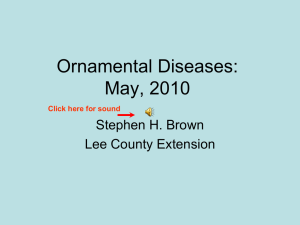
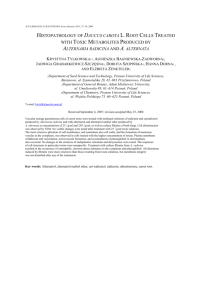
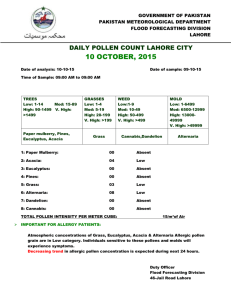
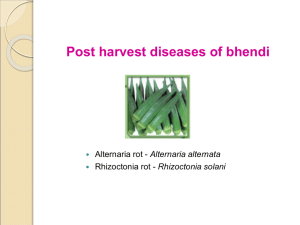
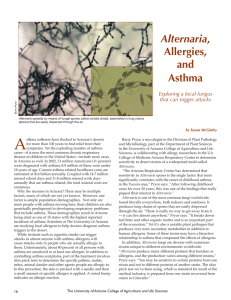
![[1] Barry's website: http://ag.arizona.edu/PLP/alternaria/online/ [2] G](http://s3.studylib.net/store/data/008567599_1-6696da84c67288cf7a604a7f7bab6db1-300x300.png)
